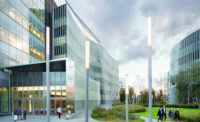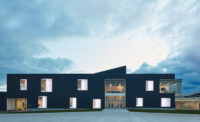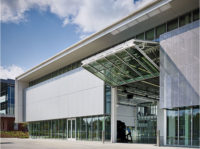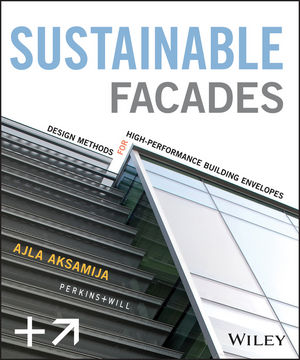An effort to strengthen and clarify the overall site plan of the medical campus with thoughtful landscaping and circulation generated an unusual opportunity to improve the medical center complex with a new addition. The 220,000-square-foot addition consists of both the cancer treatment center and ambulatory surgery center. This dual program exists on a highly constrained site. The architect was challenged to improve connections between it and adjacent, functionally related buildings, while creating landscaped outdoor rooms and walkways. The successful breakdown and articulation of scale and massing are critical in allowing an architectural transformation of function into an experience of pleasing, inhabitable spaces of light and healing.
The building consists of a treatment and technology zone, which provides a high degree of flexibility to accommodate future technology development and growth. Both the circulation and mechanical distribution system are organized on the perimeter to create a free internal floor plate, providing maximum flexibility for future changes. A support/service zone, horizontally situated and adjacent to the treatment and technology zone, provides immediate access to staff and physicians. A multistoried sunlit atrium serves as the building's spine and public zone. This area is filled with the warmth of light and views to gardens at both ends through perimeter glazing and overhead skylights.
The formal architecture of the building picks up its cues from surrounding campus structures. On the urban scale it forms a bookend to the proposed Center for Clinical Sciences Research building. The use of materials, coloration, and the formal sculpting of the north and west facades provide an interface to the adjacent Children’s Hospital and main University Medical Center. Materials and colors are oriented to the warmer hues of the traditional campus buildings. Each facade reflects both the context and internal uses, creating a formal collage anchored to fit as a permanent part of the campus. The building design seeks to create a warm, healing environment, while reflecting the sophistication for which the university and hospital are known.
|
People Owner Architect Partners in charge of Design and Planning: Project Designer: Project Manager: Project Architect: Interior Design and Furniture Specication: Project team: MEP: Civil: Consultant(s) Lighting: Code: Signage: Transportation: General contractor Photographer(s) Renderer(s) M-color: CAD system, project management, or other software used
|
Products Exterior cladding Metal/glass curtainwall: Curtain wall: Glass: Concrete: Wood: Windows Glazing Interior finishes Suspension grid: Cabinetwork and custom woodwork: Wallcoverings: Plastic laminate: Special surfacing: Floor and wall tile: Resilient flooring: Carpet: Lighting Downlights: Exterior:
|







